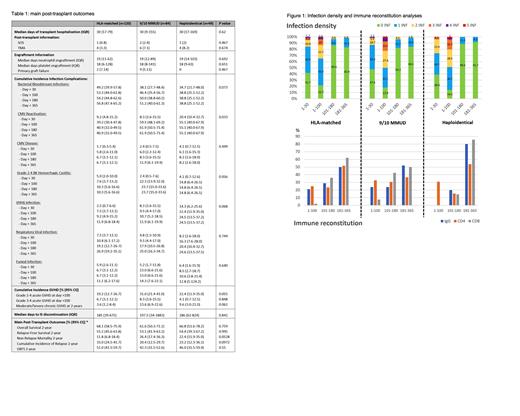Introduction
PTCY-based prophylaxis is becoming increasingly prevalent across allogeneic hematopoietic cell transplantation (allo-HCT) due to its efficacy on GVHD prevention. However, using PTCY has been associated with delayed engraftment, immune reconstitution, and high infectious complications. Although different studies have investigated how PTCY interacts with infectious risk after allo-HCT, whether the incidences of these complications differ depending on donor type has not been widely investigated.
At our institution, PTCY-based prophylaxis has become our institutional prophylaxis irrespectively of the selected donor type. This study explores the incidences of infectious complications and immune cell reconstitution dynamics in patients undergoing allo-HCT with PTCY and according to the donor type selected.
Methods
This study included the 253 consecutive adults who underwent peripheral blood allo-HCT with PTCY at our institution between 2013 and 2021. Retrospective data was updated in June 2023. All patients received levofloxacin 500mg daily from day +1 until neutrophil engraftment. No patient received letermovir. Cumulative incidences (CI) analyses have been estimated considering death as competing event and reported at day +30, +100, +180, and 1-year. Infection density was calculated by dividing the number of infections of a patient by the observed time period after allo-HCT. Immune reconstitution was evaluated by the measurement of lmmunoglobulin (IgG), CD4+T-cell (CD4) and CD8+T-cells (CD8) levels in alive patients without relapse history.
Results
The median age was 53 years (range, 18-70 years), with 44 (17.6%) patients older than 65. Acute myeloid leukemia was the most common underlying diagnosis (38%), and 103 (41%) patients received myeloablative conditioning regimens. As reported in Table 1, 120 (47.4%) patients received grafts from HLA-matched donors, 84 (33.2%) from 9/10 HLA mismatched unrelated donors (MMUD) and 49 (19.4%) from haploidentical donors (haplo-HCT).
To perform the statistical analysis, the study cohort was divided into 3 groups according to donor type. Baseline characteristics were balanced between these 3 groups, except for the proportion of patients with HCT-CI>3, higher in HLA-matched donor group (p=0.028). As shown in Table 1, 244 (96%) patients engrafted. The median of days to neutrophil and platelet engraftment, and the CIs of clinically relevant acute and chronic GVHD did not differ according to the donor type. Moreover, the duration of the immunosuppression and post-transplant outcomes were similar in all groups.
Bacterial bloodstream infections (BSI) were predominantly diagnosed within the first 30 days post allo-HCT, and with a tend to higher incidence in allo-HCT performed from HLA-matched donors (p=0.07). CMV reactivation was the most frequent viral infection in all groups, occurring mostly between days +30 and +100, and with a higher CI in the MMUD group (p=0.033). CMV disease, grade 2-4 BK hemorrhagic cystitis, VHH6 reactivation/disease and fungal infection CIs were not prevalent post-transplant complications generally occurring during the first 100 days after allo-HCT, with comparable CI differences among the 3 groups. The CI of respiratory viral infections increased steadily during the first year after allo-HCT, with similar incidences among the 3 study groups.
Infection density analysis showed comparable volume of infections complications in the 3 study groups. As shown in Figure 1, a higher infection density was observed during the first 100 days after allo-HCT (with approximately 1 or 2 number of infections occurring during that time period in most of the patients). After day +100, the number of infections progressively decreased during the post-transplant follow-up.
Immune reconstitution was measured in 139 (55%) alive patients. IgG, CD4, and CD8 levels tended to normalize in most patients from day 180 onwards, with median days to normalization of 208, 216, and 203 days, respectively, and with no differences according to donor type.
Conclusions
Patients undergoing allo-HCT with PTCY-based prophylaxis have a relevant infectious density rate during the peri-engraftment phase with no differences according to donor type.
Infectious complications decreased 6 months after allo-HCT, and in parallel with discontinuation of immunosuppression and immune reconstitution with no differences according to donor type.
Disclosures
Rosiñol:Sanofi: Other: Honoraria for lectures; Amgen: Other: Honoraria for lectures; GlaxoSmithKline: Other: Honoraria for lectures; Takeda: Other: Honoraria for lectures; Bristol Myers Squibb/Celgene: Other: Honoraria for lectures; Janssen: Other: Honoraria for lectures. Martínez-Roca:BMS: Honoraria, Other: travel grants; Abbvie: Honoraria, Other: travel grants; Roche: Honoraria, Other: travel grants; Kite: Honoraria, Other: travel grants; Gilead: Other: Travel grants; Janssen: Other: travel grants; Takeda: Honoraria, Other: travel grants. Esteve:Astellas: Consultancy; Jazz Pharmaceuticals: Consultancy, Research Funding; Abbvie: Consultancy; Kronos Bio: Research Funding; Gilead: Consultancy; Pfizer: Research Funding. Martínez:Novartis: Honoraria, Research Funding.


This feature is available to Subscribers Only
Sign In or Create an Account Close Modal